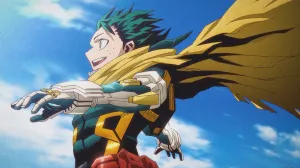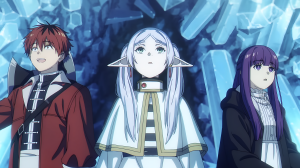It’s difficult to stay on task in Ghost of Tsushima. Whether you’re liberating a settlement or tracking down your next worthy opponent for a duel, there’s always something to distract you be it a cry for help or an animal intent on showing you Tsushima’s secrets. Distractions like those are common in open-world games, but in Ghost of Tsushima, they’re implemented with a depth that’s difficult to come across elsewhere. Impressionable characters who are as integral to the story as the protagonist Jin himself and the appeal of finding your next test of skill make getting lost a goal, not an accident.
Videos by ComicBook.com
Whether you’re plunging through the main story or putting it on hold to chase threads, much of what you’ll do in Sucker Punch Production’s Ghost of Tsushima will be familiar to those who frequent these sorts of games. Battling Mongol patrols on the road, freeing settlements to reveal points of interest around the area, and taking on your side characters’ burdens through engrossing tales make up the bulk of the Ghost of Tsushima experience. Collectibles both insightful and helpful litter the world to keep completionists and trophy hunters busy. Sometimes it’s a bit too familiar – Assassin’s Creed comparisons were apt, especially when you’re scaling a fortress wall or tiptoeing on ropes above enemies’ heads – but it’s the cinematic, stylish lens the game’s viewed from that sets it apart.
Tsushima with its crafty Guiding Wind system and abundance of locations worth exploring is a superb playground for Jin, but the setting would be nothing without a cast of characters to populate it and connect with the player. Aside from progressing the main story, the side characters have their own stories players can choose to assist with for as long as they want. Rewards range from crafting materials to stat-enhancers, but it’s their life stories of the past and present compiled into different narratives that make their missions worthwhile. Quests encompass themes of revenge, loss, and other moral quandaries stemming from the Mongol invasion.
To choose not to engage with these side quests would be like ignoring the game altogether. From Mythic Tales inspired by myths of the island to more grounded explorations of human faults and desires, Ghost of Tsushima simply has some of the most immersive and inviting side quests you’ll find in open-world games. Progression through side characters’ missions is gated by advancing through the main story, and I often found myself playing through the main campaign just to see what happens to them next. Inhabitants of Tsushima take note of your exploits even if it’s just in a quip pertaining to a recent accomplishment, but it’s those sorts of references and seeing your friends’ stories through that make the actual rewards from the missions feel more like bonuses.

Throughout your efforts to ascend Jin from man to myth and help others with their problems, you’ll find time to master Ghost of Tsushima’s combat. A rock, paper, scissors-style system where certain fighting stances work better on different enemies keeps players in control of the fight instead of just hacking away at an enemy. The ability to cancel attacks and fend off several attackers at once makes Jin both a proactive and reactive powerhouse to fulfill the game’s warrior fantasy. Jin wields an arsenal of more deceitful weapons as his story unfolds, and while they’re useful in many situations, having them all at your disposal feels like overkill at times. In the time spent picking out the right tools for the job and switching between them mid-combat, you could take out several enemies with appropriate stance usage and quick reflexes. Creativity and tactfulness are encouraged by unique combat circumstances and progression paths, so even though one way of dealing with enemies may be quicker than others, the game does a good job of promoting a healthy blend of tactics.
Despite having allies at his side, Jin very much becomes a one-man army once you’ve invested enough into his abilities and techniques. While enemies get tougher as the main story progresses, they can never keep up with Jin’s growth even though they have the advantage of numbers. With practice and the right combinations of abilities and stat-changing charms, it’s rare you’ll have to worry about dying even on the game’s harder difficulty. Damage-sponge enemies that soak up Jin’s abuse wouldn’t make much sense in Ghost of Tsushima, but heightened aggression from opponents and more varied tactics on their part could’ve made the combat more consistently challenging and rewarding.
When you strip away Jin’s deviations from the samurai path he adopts to save Tsushima, you get some of the game’s more memorable combat moments. Standoffs where you first challenge enemies to a test of reflexes demand full attention each time, and the game’s one-on-one duels are cinematic experiences that’ll leave you hunting for the next fight. One quest that exemplifies this well sees Jin set out on a Mythic Tale and engage in a series of duels before reaching the quest’s final showdown. A tense cutscene and the flick of a katana being drawn signify the start of these duals, and it’s in these moments where we see the best view of Sucker Punch’s samurai. You may choose not to keep the game’s Kurosawa Mode turned on all the time, but you owe it to yourself to turn it on for a duel at least once to see everything these limited encounters have to offer.
Even a world as robust as Ghost of Tsushima’s has to run out of things for players to do eventually, and depending on how invested you were in pursuing every thread and hunting for collectibles and ways to make Jin more powerful, you may not have much to do at a certain point other than barrel through the last few quests of the main story. My version of Jin was maxed out well before the narrative wrapped up with every ability and upgrade unlocked. That contributes heavily to the one-man army status he achieves, and it also takes some of your initiative away to clear out remaining random quests and strongholds when your main incentive of level progression is removed. It’s a situation players can only bring upon themselves by putting pretty much everything ahead of the main quest, so consider pacing out your exploits to avoid running dry towards the end.
But that solution is an easy one given the depth of exploration and combat mastery offered. Whether you want to just fight to grow your legend, see your companions’ tales through to their emotional conclusions, or just see what’s over the next hill, there’s no wrong answer when you’re asking yourself what you should be doing in Ghost of Tsushima.
Rating: 4 out of 5
Ghost of Tsushima releases for the PlayStation 4 on July 17th. A review copy was provided by the publisher, and the game was reviewed on a PlayStation 4 Pro.








